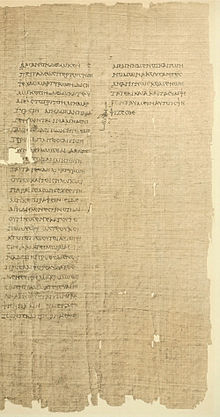
In papyrology, Maas's law — named after classical scholar Paul Maas (1880–1964) — is the observation that columns in bookrolls often exhibit a forward tilt such that both edges of a column gradually move to the left as the column progresses. In other words, the bottommost line of the column of text is further to the left than the uppermost line. William Johnson has argued that this tilt was deliberate and formed part of the bookroll's design.
Footnotes
- Johnson, William A., "Column Layout in Oxyrhynchus Literary Papyri: Maas's Law, Ruling and Alignment Dots," ZPE 96 (1993) 211-215..
- Johnson, William A., Bookrolls and Scribes in Oxyrhynchus (Toronto: University of Toronto Press, 2004; see esp. pp. 91-99)
- Obbink, Dirk, "Two New Poems by Sappho", ZPE 189 (2014).
This article about a papyrus or papyrology is a stub. You can help Misplaced Pages by expanding it. |